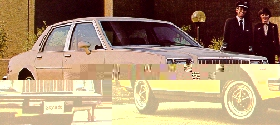
GM offered the X-cars in 3 trim levels: basic, luxury, and sporty. Not all makes offered each trim level. The varieties include:

Buick Skylark (1980-82)
Buick Skylark Custom (1983-85)
Buick Skylark Limited
Buick Skylark Sport Sedan/Coupe (1980-82)
Buick Skylark T Type (1983-84)
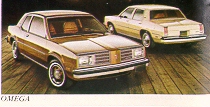
Oldsmobile Omega
Oldsmobile Omega Brougham
Oldsmobile Sport Omega (1980)
Oldsmobile Omega ES 2500 and 2800 (sporty version; the number indicated
the engine ordered with the car) (1982-83 at least; maybe longer)
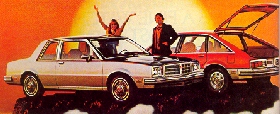
Pontiac Phoenix
Pontiac Phoenix LJ (luxury- changed to LE in '84)
Pontiac Phoenix SJ (sporty- changed to SE in '84)
Chevrolet Citation (1980-83)
Chevrolet Citation II (1984-85, renamed because "16 mechanical
improvements" were made; I'm not sure what they were - sales were slowing
by this point & Chevy thought a renaming might help)
Chevrolet Citation X-11 (sporty version- 1980-82 only I believe)
Chevrolet Citation Club Coupe (1980, 1982-85)
Notchback 4 door sedan: Skylark, Omega
Notchback 2 door coupe: Skylark, Omega, Phoenix
Hatchback 5 door sedan: Phoenix, Citation
Hatchback 3 door coupe: Citation
Slant back 2 door club coupe: Citation
You can easily determine the year of the car you see by looking at the
7th (1980) or 10th (1981 on) VIN number.
A=1980
B=1981
C=1982
D=1983
E=1984
F=1985
Or you can look at the build date on the sticker on the driver's door.
September through August is the model year (i.e. 9-81 and 4-82 would be
1982 models). Some 1980 models were built as early as March 1979,
however.
It's usually more fun to figure out what year a car is by its subtle styling changes. Usually this entails changes to the grille and/or taillights. In my opinion, the '80 and '81 styling of all the X cars across the board is the coolest.
One thing that may be confusing at times is that you look at a car and realize the front and rear styling were not used the same year- leaving you thinking- ok, what year is this X car? What often happens is that people get into front or rear collisions, and when the body shop puts on a new grille or set of taillights, they just get whatever they can get and put it on there. They just care that it fits and looks normal, not that they get the exact same grille or taillights or whatever for that particular year car. I've seen a lot of 80 Skylarks with 81 grilles, or 84 Skylarks with an 80 front end, etc. In these cases the only way to know for sure is to check the 10th VIN digit, though knowing what dash/steering wheel/interior was offered which year can help.
These photos are necessarily the most complementary examples. Some photos are from auto literature that I have of the X cars. Hwowever, I did not have literature from the later (83-85) cars, and also no Citation literature. In order to find a concentration of X cars for some other photos, I went to the local salvage yards, or shopping mall parking lots, which didn't always turn up the prettiest examples. Should you have better photos of cars for me to view, send 'em along! Just make sure they are SMALL jpg images, otherwise I won't have enough memory on my account to load them up.
1980
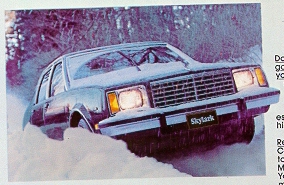

1980 versions had an attractive cross-hatched grille, and red and orange taillights which extend across the back of the car(orange turn signals). The gauges had a silver background with black lettering, and a steering wheel which looked like an upside down V (as on all '78 to '81 Buicks). Most 1980 versions also have decals on the front fender indicating which engine is under the hood. Interiors included: 1. vinyl, 2. cloth, 3. plaid cloth and vinyl, and 4. Limited velour seating (quite comfortable!).
1981
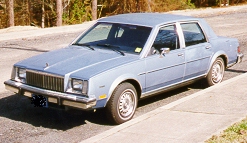


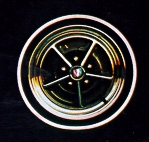


This year, Buick changed the grille to being a vertical type having heavy bars every fourth bar, with smaller ones in between. It is reminiscent of the 78-79 Buick Regal grille. Continued from 1980 in front of the car is the headlight styling which is somewhat recessed from the grille. Taillights this year became all red in back. They continue to be flush with the back of the car, and are split in half horizontally by a thin horizontal black strip. Also new this year were gauges having black backgrounds with white lettering. The upside down V steering wheel continued. The plaid interior was dropped.
1982
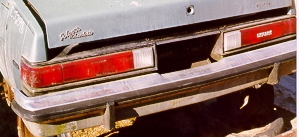
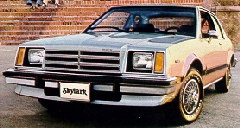

Major styling changes were made to the front and rear of the car. New was a flush (instead of bumped out) vertical grille with widely but evenly spaced vetical bars. Front turn signals were moved between the headlights and the grille (previously outside of the headlights). The rear of the car had new bumped out taillights not having a thin horizontal piece in the middle (quite un-Buick like in fact). Some cars had "Skylark" written on the right hand taillight itself. In '82 the entire Buick lineup got new steering wheels- looks like an "A" with the top cut off. White on black gauges continued.
1983
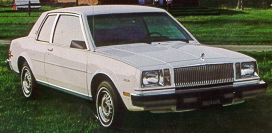

The 83s have the exact same grille and front end as the 82s. However, the taillights were revised: they continued to be bumped out, but this time the thin horizontal black strip returned. New to the exterior was the styling of the trunk itself. Now, a horizontal crease was created across the back, whereas in 80-82, the trunk didn't have this crease. Also in 80-82 the trunk had a vertical crease running down the center- this was removed in 83. Also new was the addition of mirrors integral with the front doors. Previous mirrors had been post-mounted.
The most significant change made was to the interior. The dashboard was lengthened a few inches to accomodate the new Delco electronic radios which Buick had begun offering the previous year in the new front wheel drive Century. The seats themselves were also changed. 3 interior options were now available: The base Skylark (now Skylark Custom) got a new "houndstooth" cloth interior with integral headrests, or vinyl bench seating. The Limited got firmer velour seats with movable headrests. The seating position for the driver and front passenger is somewhat higher in these later models, improving view of the road significantly.
The styling of the door panels was also changed. In 80-82, simulated wood decor trim made a little trapezoid on the door panels. In 83, this was updated to simulated wood decor trim running across and then up the inside of the door at a 45 degree angle.
1984
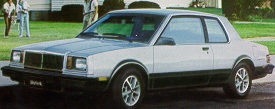
Pictured above is a T type coupe. The front of the Custom/Limited was different than the T Type, and from the 83 Custom/Limited. Little else was changed from 83. The interiors, steering wheel, and taillights were all the same. However, a new grille was added-this grille had horizontal and vertical pieces- giving it sort of a "waffle" look. Skylark production in 1984 was 105,000 cars.
1985
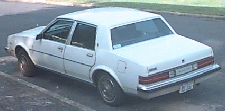
This, the final year of the X-body Skylark, saw styling changes to the
front and rear of the car. A new grille was added having closely spaced
thin vertical bars. The taillights once again became flush with the rear
of the car. They had a thin silver horizontal strip. The lenses
themselves were slightly bigger, also. They look like the taillights of
a mid-80s Regal. This year, the license plate was moved down into the
bumper, and a silver plate having "Buick" embossed on it in black
lettering was placed between the taillights (where the license plate had
been on the 80-84 models).
The Skylark coupe was no longer offered in '85- this year sedans only
were built. 93,000 cars were produced- still a very good seller even without the coupe body style.
Skylark coupes, Omega coupes, and Phoenix coupes look totally different from the side, even though they are all of the notchback variety. The Skylark coupe has a rounded off rear passenger window, while the Omega has a squared off window here. The Phoenix coupe has a trapezoidal window here that is quite different from the Omega's.
1980
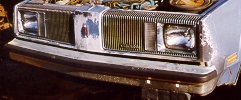
For 1980, the Omega debuted with a "waterfall" type grille typical of Oldsmobile at the time. The grille started up on top of the front end and then turned down 90 degrees. The grille had thin, close together, evenly spaced vertical bars running down it. As per Oldsmobile tradition, the grille is split in half in the middle. The ends of the front fenders jut out slightly- a neat appearance in my opinion. Also typical of Olds are the thin vertical taillights used in the rear. The steering wheel is an upside down V not quite the same as Buick's. The gauges were black lettering on a silver background this year.
1981


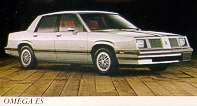
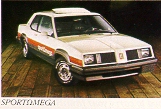
81 Omegas have a slightly different grille. The bars are more widely spaced, and horizontal ones were added also. The rear taillights are thin and vertical but a small silver stripe runs down the middle. Black gauges with white lettering were added inside.
1982

In 82, the front and rear of the car was significantly changed. A new flat front end was added, with a waffle style grille having large squares. Turn signals were moved inside and behind the grille. The rear of the car had large, somewhat square taillights split in half vertically by a silver bar. Reverse lights were moved into the bumper itself (I believe). A new steering wheel was added (across the entire Olds lineup). This steering wheel has a square center with two small horizontal bars jutting out from the bottom. It sort of looks like an upside down "T".
1983
 The rear of the car remained the same as in 82, but a more attractive
grille was added. It also was a split grille having a waffle pattern,
but it had much smaller squares and the bars were thinner. The whole
front end echoes the styling of the car much better than in 82.
Significant changes were made to the interior, as was the case with the
83 Skylark. The dash was completely redesigned- no more simulated wood
decor. Interior logos on the gauges and in the interior were made to look
more "modern". Seats were firmer as well.
The rear of the car remained the same as in 82, but a more attractive
grille was added. It also was a split grille having a waffle pattern,
but it had much smaller squares and the bars were thinner. The whole
front end echoes the styling of the car much better than in 82.
Significant changes were made to the interior, as was the case with the
83 Skylark. The dash was completely redesigned- no more simulated wood
decor. Interior logos on the gauges and in the interior were made to look
more "modern". Seats were firmer as well.
1984
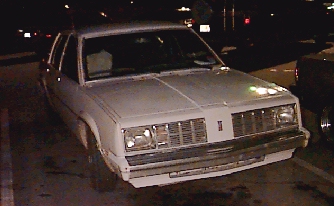
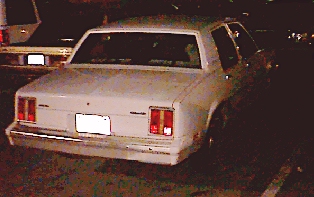
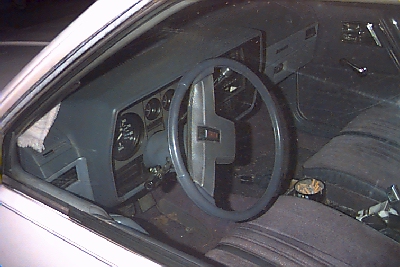
Again, the rear of the car was left unchanged, but the grille was modified slightly. It now had thin bars closely spaced horizontally, with 3 vertical bars, giving the grille a "sectioned" look to it.
Alas, this was the last year of the Omega's production. The surge in popularity of the newer Cutlass Ciera had been cutting into Omega sales significantly since 82. Only 22,000 Omegas were made in 84. A similar situation was occuring at Buick: the new front wheel drive Century was reducing Skylark sales, but not as dramatically.
The Pontiac Phoenix 4 door sedan came only as a hatchback, and thus it is often mistaken for the similar looking Chevy Citation. The Phoenix coupe, however, was a notchback version, and looks more like a Skylark or Omega coupe. The Phoenix from the rear differs from its Olds and Buick counterparts in that it had louvered taillights. Also, the front end juts out slightly in the middle, giving it a look all its own.
1980

The 1980 Phoenix, as mentioned, had louvered taillights, and a jutted out front end. The grille was in a waffle pattern with large rectangles. The steering wheel was of a 3 spoke design. Gauges were in black, but used the same style lettering found on the 80-85 Skylarks and 80-82 Omegas. Phoenix gauges were numbered "0, 10, 20, 30" etc, while Skylark and Omega gauges were numbered "5, 15, 25, 35" etc. Unlike the Buick and Olds versions, the Phoenix had horizontal heater controls (the other cars had vertical slider bars for the climate control).
1981
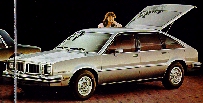
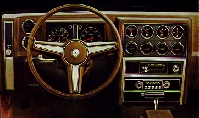
The 81 Phoenix front grille was changed to evenly, widely spaced heavy vertical bars, having very thin horizontal bars in between that were angled into the grille and over to the next bar- hard to describe unless you see it, but its cool. Similar to the 79-81 or so Pontiac Catalina's grille. The front end continued to be jutted out. Taillights and steering wheels continued as in 80.
1982



No styling changes I know of were made to the car, except for a cool new steering wheel was added having downswept spokes with "Pontiac" printed in the center.
1983

A major effort was made by Pontiac to give the Phoenix sportier styling. A new blacked out grille was added containing very thin bars. The interior seating was redesigned. Chrome on the doors was no more- blackout trim was added.
1984

Very little was changed compared to 83. The one difference I know of was that the dash was changed to having an orange background, instead of white. Very few 84s were produced (about 17,000 I believe). By this time, the sales of larger Pontiacs, such as the 6000, were surging and outcompeting the Phoenix.
The Citation 4 door looks a lot like the Phoenix hatchback except that the side window behind the back door has a slightly upcurved styling to it, whereas the Phoenix's window is styled straight across at the bottom. The Citation was also offered as a 2 door hatchback, and a 2 door "slant back" club coupe having a trunk separate from the passenger area (except in 1981 only, the slantback coupe was not available- I have no idea why). The club coupe version of the car is rare as very few were produced. Personally, it is my favorite Citation.
1980
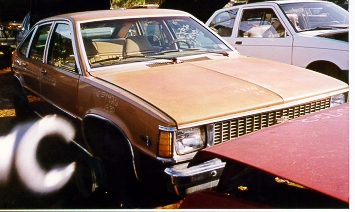
1980 was Citation's finest year in terms of sales- over 800,000 (yikes!) of these cars were produced, making it the most popular new car in America at the time! Chevy was hard-pressed to meet demand! High production rate led to poor quality control on these models, however. Styling included a flat waffle type grille with small rectangles and thin bars. Taillights were red with orange turn signals. The Citation was unique in that it had a vertical layout for the climate controls AND the radio- it is quite unusual for cars in general to have a vertical radio. I don't know of any other car ever produced like this, except a 1968 Rebel. (A car produced by AMC, for those who don't remember the 4th American automaker.) The dash itself consists of large squared off instruments (regular version- standard equipment) or circular gauges (gauge style- optional equipment).
1981

The grille was revised: still flat, it had larger rectangles in a waffle pattern with heavier bars. Taillights became all red, I believe.
1982-85

No styling changes I know of were made in these years. One difference from the 81s was a flat grille having all thin horizontal bars which are evenly spaced. Some years had orange turn signals in the rear, I believe, but I don't know which years. The 84 and 85 versions became called the "Citation II". The name change was due to 16 mechanical improvements which were made, but I have no idea what these improvements were. The 85's had a completely new instrument cluster and dash design.
Ok, that was pretty exhaustive, wouldn't you say?